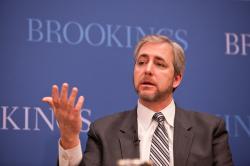An analysis at the national and metropolitan levels of commercial air travel patterns between 1990 and 2009 reveals that:
- Air passenger travel in the United States experienced its first annualized drop in September 2008 since the tragedy of September 11, 2001, and the decline has continued through March 2009. Strong economic growth helped American airports increase their passenger and flight levels by over 60 percent from 1990 to 2008, tripling population growth. However, residents are traveling less since the current economic downturn, producing sustained reductions in passengers and flights since September 2008 and June 2008, respectively.
- Nearly 99 percent of all U.S. air passengers arrive or depart from one of the 100 largest metropolitan areas, with the vast majority of travel concentrated in 26 metropolitan hubs. Between April 2008 and March 2009, 26 metropolitan areas captured nearly three-quarters of all domestic travelers, while 20 of these metros landed 94 percent of all international passengers. These extreme shares make these metropolitan hubs the critical links in the nation’s aviation system and reinforce their role as major centers of tourism and commerce.
Half of the country’s flights are routes of less than 500 miles, and the busiest corridors travel between the metropolitan hubs. Corridors of no more than 500 miles constituted half of all flights and carried 30 percent of all passengers in the most recent twelve month period starting April 2008. In fact, the metro Los Angeles/San Francisco corridor, stretching 347 miles, is the second busiest corridor in the country. Meanwhile, the most popular corridors operated between the 26 metropolitan hubs. The 26 metropolitan hubs and other large metropolitan areas host a concentration of national delays—and the situation is worsening over time. The concentration within the 100 largest metropolitan areas was especially troubling with congestion-related delays as well as those lasting over two hours. Within the 26 domestic hubs, six experienced worse-than-average delays for both arrivals and departures: New York, Chicago, Philadelphia, Miami, Atlanta, and San Francisco.The current economic recession caused carriers to reduce flight levels, which then improved ontime performance in the immediate term. However, the return of economic growth will resume the boost in travelers, a concomitant decline in on-time performance, and the hyperconcentration of U.S. air travel within major metropolitan areas and among flights traveling short distances. To ensure that the commercial aviation system runs efficiently while simultaneously improving its environmental record, policymakers must focus aviation and other modal investments on the metropolitan hubs and short-haul corridors, thus strengthening the performance of the our nation’s major economic centers.
Supplemental Reports
An Analysis of Air Travel Trends in the Great Lakes Region »
An Analysis of Air Traffic Patterns in the Intermountain West »



